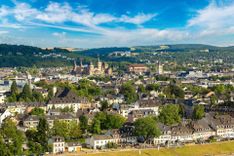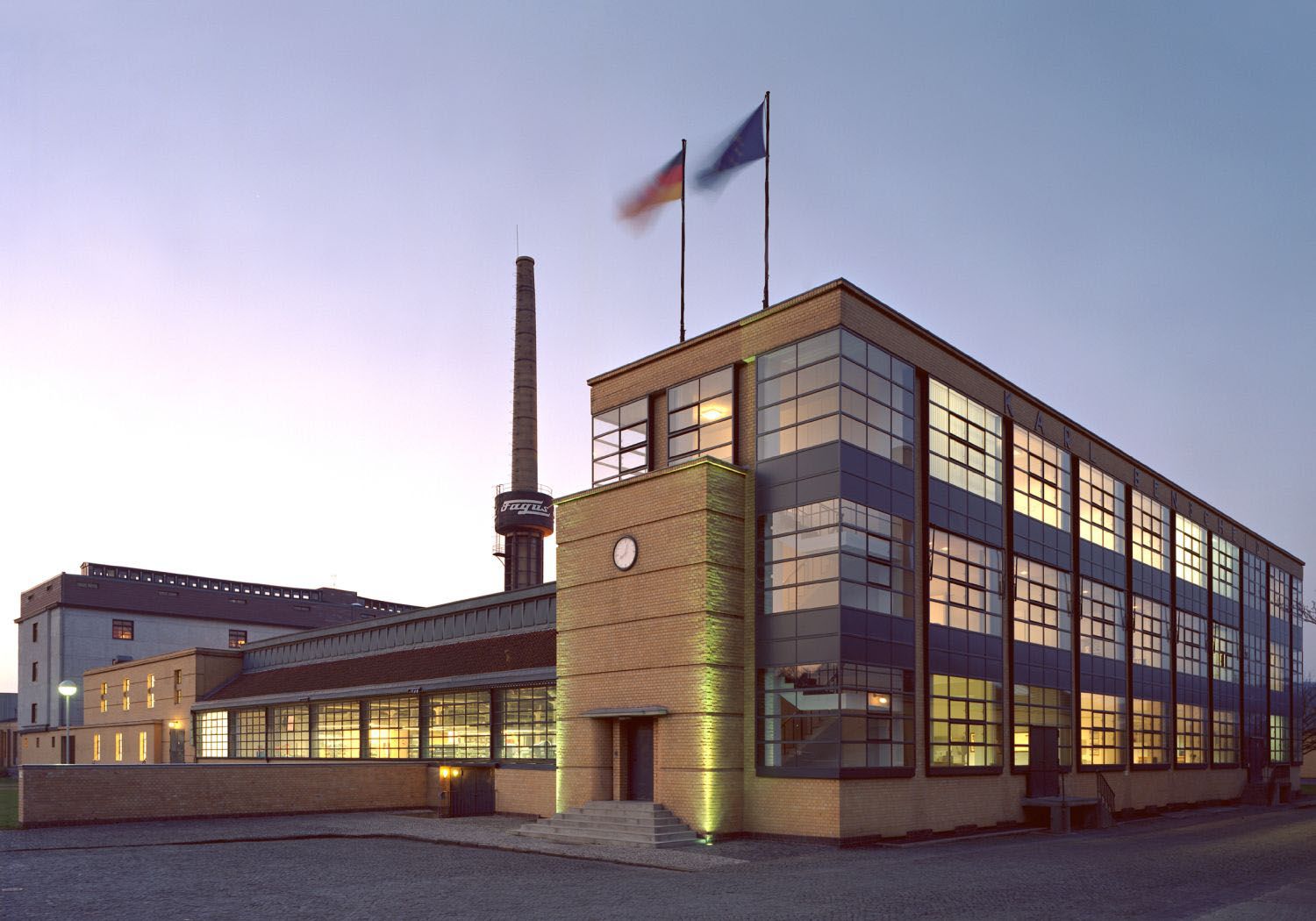Planning your own trip? Prepare for your trip
Use Rough Guides' trusted partners for great rates
Book your individual trip, stress-free with local travel experts
Germany has long been at the forefront of global architecture and design. The birthplace of Bauhaus style, the country’s Modernist credentials are well documented. Splendid examples still exist today, recognized as World Heritage sites and conceived by big-name hitters including Ludwig Mies van der Rohe, Walter Gropius and Le Corbusier. They really will blow your socks off.






























Simple and abstract are perhaps two of the best terms to describe the Bauhaus style. This type of modernist architecture was more than a style, though; it was a movement and crossed into new territory by successfully combining the arts and architecture. Established more than one hundred years ago, many Bauhaus sites can still be visited today, with the chance to gain a deeper insight into all things Bauhaus through informative museums and exhibitions. Guided tours are another way to find out more from art, design and architecture experts and enthusiasts.
In some cases, the buildings have been expanded or reworked since their original construction, which symbolizes the continued success and legacy that this architectural movement has imprinted on the world.
Bauhaus first burst onto the scene in 1919, with the World Heritage Bauhaus University in Weimar covering a long stretch of land with wide, symmetrical windows that curve to the red roof. The movement continued its success in Dessau, where the emphasis on modernity continued. Buildings such as the Masters’ Houses (used by the university professors as their living quarters) provide excellent early examples of Bauhaus design.
Dessau is home to many other Bauhaus buildings: Gropius’ Bauhaus Building, which has “Bauhaus” printed in giant block capitals down one side; the curved-ended Kornhaus; and the Dessau-Torten Housing Estate, whose balconies demonstrated the development in social housing. There’s even a low-rise refreshment kiosk, which truly symbolizes the versatility of the style!
In Bernau, the ADGB Trade Union School was designed by Hans Wittwer and Hannes Meyer, and opened in 1930. It is a unique Bauhaus gem, set in a natural landscape. But what truly distinguishes it is its sheer size: once used as a training centre for trade unionists (hence its name), today it is used as a boarding school.

Prellerhaus: Bauhaus in Dessau © DZT / J.D. Andrews
At the beginning of the 20th century, Berlin was in dire need of low-income housing. Part of the solution came in the form of six Modernist housing estates, built between 1913 and 1934. Far removed from the gloomy tenements of the German Empire, these contemporary estates were of modernist design – they were welcoming and embraced a sense of community.
Not only were they well designed by reputable architects such as Bruno Taut and Martin Wagner, but they were affordable for everyday Germans. The estates were innovative for their time, and remain just as popular today, while simultaneously paying homage to the appealing architectural style.
The Gartenstadt Falkenberg (Falkenberg Garden City) was designed by Bruno Taut and built between 1913 and 1916. The estate is centered around a courtyard as a way to instigate a community-like feel, with the colourful buildings ranging from terraced to semi-detached. Taut didn’t want the estate to follow a symmetrical layout, as if to imply that the buildings are as individual as the people who live there.
Another of Taut’s designs is the large Britz Estate, otherwise known as the “Horseshoe Estate” thanks to its distinctive layout. This multi-level, flat-roofed estate is recognized as a World Heritage site (excluding the early 1990s additions). Each apartment has its own garden – or view overlooking one – along with an interior of contrasting colours and modern windows that welcome in more light.
For those planning to take a tour of the estates, it’s vital to factor in plenty of time to do them justice, as they are spread across Berlin. Not only will a guided tour explain more about the architecture and overall design and appearance of the buildings, but some include the opportunity to tour the inside, too. At Britz Estate, for example, there’s no missing the 1920s-style “Taut’s House”, which the architect designed himself and used as a holiday home.
Taut’s other buildings of timeless design include the Netherlands-inspired Schillerpark Estate and balcony-clad Wohnstadt Carl Legien. Other prominent architects of the Modernist housing estate project included Martin Wagner (“Siemens Town”, Weisse Stadt), Hans Scharoun (who co-designed “Siemens Town”), Hugo Haring and Walter Gropius.

Bruno Taut-designed houses in Falkenberg Garden City © Lookphotos/Guenther Bayerl
Designed by Adolf Meyer and Walter Gropius (of later Bauhaus fame), the functionalist Fagus Factory is a cultural highlight of Alfeld, Hanover and Lower Saxony as a whole. Construction started in 1911 and commenced in three phases; upon completion it was hailed as the first truly modernist structure.
Gropious used original ground plans laid down by architect Eduard Werner and added his own and Adolf Meyer’s designs to create a factory complex spanning ten buildings, which included a timber-beamed warehouse and glass-fronted workshop.
One of the most appealing facets of the factory wasn’t just the shoe lasts it produced, but how its architectural design broke away from the existing values of the early 20th century. The factory is a triumph in modern architecture, combining a futuristic yet elegant design, with its low-set flat roof, tall, skinny tower and vast glass panels. In fact, some of the glass panels wrap around corners and are completely unsupported, which was an element that architecture hadn’t seen before.
Yet following extensive restoration work, the factory still sports its original design and is still in operation today – the only World Heritage Site in the world with that claim to fame. The factory still produces shoe lasts, too; originally made from beechwood (Fagus is Latin for beech tree), since the 1970s they made the switch to plastic. The shoe lasts are not just made here, but are also stored and shipped on site, too.
A visit to the Fagus-Gropius exhibition will prove interesting for anyone looking to understand more about modernist architecture and glean further details about the factory. Set within the production area of the site and spread across five floors, there are glass displays of various high heels, trainers and boots, as well as shoes that celebrities have previously worn. Stylish shoes aside, there’s the chance to learn about the history of the company, changing shoe trends over the past century and more about the factory workers themselves. There’s also original Bauhaus works on display, designed by Gropius himself, along with more information about the Bauhaus movement, which followed the modern designs of the Fagus Factory.

Fagus-Werk © Lookphotos/Guenther Bayerl
The Weissenhof housing estate may have been constructed in 1927, but its design was way ahead of its time. Alongside the modernist housing estate is a museum, housed in one of the buildings, where visitors can find out more about the architect and the key design elements used.
The architect responsible for this progressive structure was Charles-Edouard Jeanneret-Griss, or Le Corbusier, whose forward thinking was reflected in his designs, which also represented changing attitudes among the German population. It was built by Ludwig Mies van der Rohe
Also referred to as Werkbundsiedlung, this housing estate consists of 33 buildings, with eleven left standing today. Although many were sadly destroyed during World War II, those that remain are World Heritage Sites; Le Corbusier has a total of seventeen of his works on the World Heritage List, an impressive feat for any architect.
Situated in Stuttgart, the estate is made up of white cube-like buildings, “propped up” by slim, painted pillars; long and short strips of square windows; and a flat, partly covered rooftop. Not only did the flat rooftop provide a communal, open-top space, but the light and airy living spaces were well-received as ergonomical and versatile.
While visitors cannot access the properties on the estate, there are a pair of semi-detached houses that are home to the Weissenhofmuseum. The museum details the chronological history of the estate through models, photographs and various objects on display, with the layout based on the original residential floor plan. In another area of the museum, visitors experience the adaptability of Le Corbusier’s living spaces, such as the beds that roll out from beneath the cupboards to create a bedroom. The museum spans the ground and first floors of the building, while on the top floor is a library with more information about Le Corbusier, along with models of the buildings and a couple of the architect’s books on display.
One of the most appealing things to do is to head up to the renowned rooftop, which not only features a pleasant flower garden, but also offers sublime views across Stuttgart.

Le Corbusier and Pierre Jeanneret's Weißenhofsiedlung, 1927 © SMG / Achim Mende
Hamburg was once a thriving global trading power, and the Speicherstadt and Kontorhaus districts are living examples of Hamburg’s expression of modernity. Today, they make up a vibrant cultural quarter.
Speicherstadt is a former warehouse district, once the world’s largest warehouse complex and the beating heart of Hamburg’s port. Its tall, neo-Gothic brick buildings were constructed between 1885 and 1927 and line each side of the river. While the redbrick buildings remain, many are now home to trendy restaurants. The best views of this historic district can be enjoyed from a harbour tour, or by simply wandering through the streets and across the steel bridges, all while imagining the aromas that must have once drifted through this high-rise district: tea, coffee and spices, among other delicacies.
But the merchants needed office space, and so they developed the nearby Kontorhäuser district, with many of its administrative buildings dating back to the 1920s. The most renowned is the striking Chilehaus: designed by Fritz Hoger, built by Henry B. Sloman and opened in 1928, the site is as impressive today as it was a hundred years ago. The building is a unique, streak-like shape, with its pointed eastern tip reminiscent of the prow of a ship. An incredible 4.8 million bricks were laid by hand, while reinforced concrete also makes up part of the structure. The inside of the building is a versatile space, and as such accommodates a range of functions, from 5200 square metres of retail and storage space to 25,000 square metres of office space.
This giant of Brick Expressionism also features a seemingly endless flow of windows, much like the neighbouring Sprinkenhof. The Sprinkenhof, which fully opened by 1943, was completed in three phases – it was once the largest building in the city.
This exciting cultural quarter boasts plenty more to see and do: have an authentic experience at the Speicherstadtmuseum, housed in a former warehouse building; see all things gruesome at the Hamburg Dungeon; and embrace high culture at the Elbe Philharmonic Hall. In between all the sightseeing, make time for coffee at one of the old-established roasting houses, sample chocolates from traditional chocolate-makers and wind down the evening at an atmospheric harbourside pub.

Hamburg Speicherstadt Wasserschloss © Michael T. Meyes
Find out more about Germany's World Heritage gems by downloading our free eBook
 This content was created in partnership with the German National Tourist Board.
This content was created in partnership with the German National Tourist Board.
From travel safety to visa requirements, discover the best tips for visiting Germany
Discover Germany's most captivating stories
Use Rough Guides' trusted partners for great rates
written by
Rough Guides Editors
updated 06.03.2025
Arrange your trip, hassle-free, with local travel experts
Arrange your trip with local travel experts